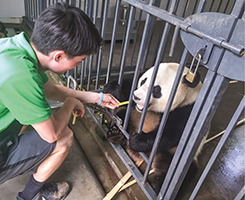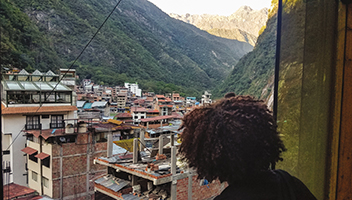
How an Urban District Sends Students Abroad
BY KAYLA GATALICA AND LAURA C. ENGEL/School Administrator, January 2019

|
A District of Columbia Public Schools student visits the Giant Panda Conservation Center in Chengdu, China, as a participant in the district’s study abroad program.
|
In winter of his junior year, a student named Jonathan (a pseudonym) was shot in his Washington, D.C., neighborhood. Doctors told him he would never walk again. He was 15. Six months later, Jonathan boarded a plane to Peru, on his way to visit Machu Picchu and the Sacred Valley.
“I don’t want to be a stereotypical statistic,” he wrote in his application to the District of Columbia Public Schools Study Abroad program. “[T]he world is so much bigger than Southeast D.C. … Going on this trip will expose me to new things I’ve never seen, introduce me to new people, teach me about how those people are living, and more.”
The district’s unusual study abroad program is a fully funded global travel program (dcpsglobaled.org) launched in 2016 with about $2 million in private funding and sustained with city government funds in FY ’18. DCPS Study Abroad makes global learning through travel equitably accessible to middle and high school students, such as Jonathan, who are studying world languages and are curious about new people and places.
Cajoling Participation
The Institute for International Education’s annual Open Doors report in 2018 showed only 28 percent of study abroad participants nationwide identify as people of color, putting DCPS at the forefront of diversification efforts. An urban district serving 82 percent students of color, with three-fourths of students eligible to receive free and reduced-price meals, DCPS values equity in its work. The most recent evaluation of the DCPS Study Abroad program indicated that 91 percent of participants identified as students of color and 85 percent were low-income.
Students apply to DCPS Study Abroad. To recruit them, the district involves school-based educators called travel ambassadors. They are trained to recruit, select and prepare students for global travel, and they accompany students on their global adventures. Leveraging the trusting relationships they have within their school community, the ambassadors reach out to students for whom the concept of travel is new and sometimes hard to imagine. Community engagement events educate families about the program, and trip-specific pre-departure meetings allow students and families to learn more about their destination and travel generally.
In schools and neighborhoods where a culture of travel may be nascent, the travel ambassadors communicate the benefits of global travel — by highlighting the advantages of practicing world language skills in context, for example — and educate their audience about the process of travel — by, for instance, explaining the steps involved when applying for a passport.

|
A high school student in the District of Columbia Public Schools’ study abroad program gazes out over his host community in Peru.
|
Cost Barriers
Travel is costly. Like many school districts, the D.C. Public Schools balances considerable needs against limited resources. Why should the district spend thousands of dollars to send a group of 20 8th graders on a language immersion trip to Costa Rica? Why fund costly airfare and tourist visas associated with facilitating a service learning trip to China for 20 high schoolers? In a district where fewer than 40 percent of students are proficient in math and literacy, according to 2018 PARCC data, some may argue this money could be used well elsewhere.
In response, we note that academic interventions, by and large, are expensive and do not always achieve the desired outcomes. As an intervention, DCPS Study Abroad is surprisingly cost-effective, particularly in light of the range of positive outcomes associated with the program. Researchers at George Washington University’s Graduate School of Education and Human Development found participants exhibited enhanced sense of self-identity, engagement in learning, self-confidence and leadership, positive peer relationships and motivation to seek global college and career opportunities.
By removing cost barriers that ground would-be travelers, DCPS is transforming the way student travel is discussed in Washington and elsewhere. To date, DCPS Study Abroad has provided fully funded travel to 18 countries on five continents for more than 1,400 students and educators. DCPS doesn’t have to be the only district doing this transformative work at scale. In fact, we hope it won’t be.
KAYLA GATALICA is manager of global programs for the District of Columbia Public Schools in Washington, D.C. LAURA C. ENGEL is associate professor of international education and international affairs at George Washington University in Washington, D.C.